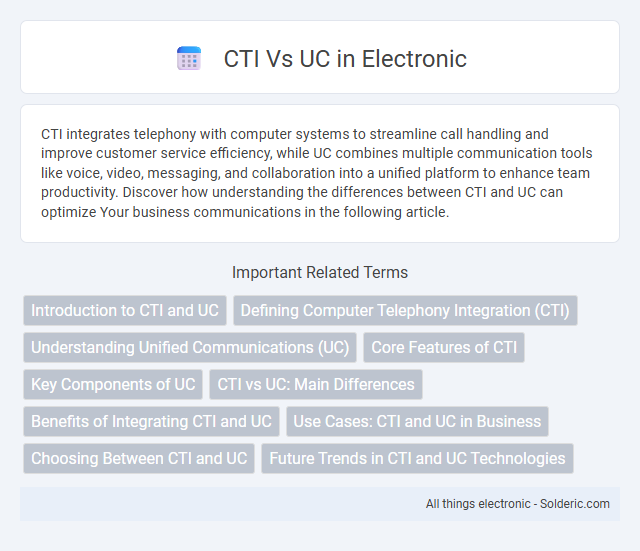CTI integrates telephony with computer systems to streamline call handling and improve customer service efficiency, while UC combines multiple communication tools like voice, video, messaging, and collaboration into a unified platform to enhance team productivity. Discover how understanding the differences between CTI and UC can optimize Your business communications in the following article.
Comparison Table
| Feature | CTI (Computer Telephony Integration) | UC (Unified Communications) |
|---|---|---|
| Definition | Integration of telephone systems with computers to enable enhanced call control and automation. | Consolidation of multiple communication tools (voice, video, messaging) into a single platform. |
| Core Functionality | Call control, click-to-dial, screen pop-ups linked to CRM. | Instant messaging, video conferencing, VoIP, presence information. |
| Primary Use Case | Improving call center efficiency and customer service automation. | Enhancing team collaboration and real-time communication. |
| Communication Channels | Primarily telephony calls. | Voice, video, chat, email, and file sharing. |
| Technology Focus | Telephony integration with CRM and business applications. | Unified platforms combining multiple communication services. |
| Examples | Avaya CTI, Cisco CTI, Genesys CTI. | Microsoft Teams, Zoom, Cisco Webex, Slack. |
Introduction to CTI and UC
Computer Telephony Integration (CTI) enables seamless interaction between telephone systems and computer applications, enhancing call management and data retrieval during customer interactions. Unified Communications (UC) combines various communication tools such as voice, video, messaging, and collaboration platforms into a single unified interface to streamline business communication. Your choice between CTI and UC depends on whether you prioritize integrated telephony control or a comprehensive communication ecosystem.
Defining Computer Telephony Integration (CTI)
Computer Telephony Integration (CTI) enables the seamless connection between telephone systems and computer applications, enhancing call control, data retrieval, and customer interaction management. CTI empowers Your customer service agents by automating call routing, screen popping relevant information during calls, and logging communication history for improved efficiency. Unlike Unified Communications (UC), which integrates various communication tools like messaging, video, and conferencing into a single platform, CTI specifically bridges telephony functions with CRM and business software to optimize call handling.
Understanding Unified Communications (UC)
Unified Communications (UC) integrates multiple communication tools such as voice, video, messaging, and collaboration platforms into a seamless experience, enhancing real-time interaction and workflow efficiency. Unlike Computer Telephony Integration (CTI), which primarily connects telephone systems with computers to manage calls, UC provides a broader, more flexible platform for unified messaging and collaboration across devices. Your business can leverage UC to streamline communication channels, improve productivity, and foster teamwork in a cohesive digital environment.
Core Features of CTI
Computer Telephony Integration (CTI) primarily enhances call control functions by linking telephone systems with computers to streamline communication workflows. Core features include screen pop-ups displaying caller information, call routing automation based on data from CRM systems, and click-to-dial capabilities that boost agent productivity. Integration with customer databases and real-time call monitoring also enables improved customer service and efficient call management in contact centers.
Key Components of UC
Unified Communications (UC) integrates key components such as voice, video, messaging, presence, and collaboration tools into a single platform, streamlining business communications. Unlike Computer Telephony Integration (CTI), which focuses primarily on linking telephony with computer systems, UC offers a holistic solution that enhances your team's productivity and communication efficiency. These components enable seamless interaction across devices and channels, supporting real-time engagement and unified workflows.
CTI vs UC: Main Differences
CTI (Computer Telephony Integration) primarily enhances traditional phone systems by integrating telephony with computer applications, enabling features like call control and screen pop-ups. UC (Unified Communications) encompasses a broader range of real-time communication tools, including voice, video, instant messaging, and collaboration platforms, unifying multiple communication channels into a single interface. Your choice between CTI and UC depends on whether you need enhanced telephony functions or a comprehensive communication solution across various media.
Benefits of Integrating CTI and UC
Integrating Computer Telephony Integration (CTI) with Unified Communications (UC) enhances customer experience by enabling seamless call control and real-time data access during interactions. This integration streamlines workflows, improves agent efficiency, and reduces call handling time through synchronized communication channels and automated process management. Businesses benefit from unified contact management, detailed analytics, and improved collaboration across voice, messaging, and video platforms.
Use Cases: CTI and UC in Business
Computer Telephony Integration (CTI) enhances customer service centers by enabling seamless call control, screen pops with caller information, and automated call routing, improving agent efficiency and customer satisfaction. Unified Communications (UC) platforms integrate voice, video, messaging, and collaboration tools in real-time, supporting remote work, team collaboration, and expedited decision-making processes. Businesses leverage CTI for optimized contact center operations while UC facilitates broader communication needs, ensuring streamlined workflows and enhanced productivity across departments.
Choosing Between CTI and UC
Choosing between CTI (Computer Telephony Integration) and UC (Unified Communications) depends on your business needs for communication efficiency and integration. CTI enhances traditional telephony by integrating phone systems with CRM and other software, improving call handling and customer interactions. UC offers a broader solution by combining voice, video, messaging, and collaboration tools into a single platform for seamless communication across devices.
Future Trends in CTI and UC Technologies
Future trends in CTI (Computer Telephony Integration) and UC (Unified Communications) technologies emphasize AI-driven automation, advanced analytics, and cloud-based platforms to enhance customer experience and operational efficiency. Integration of AI-powered virtual assistants and predictive insights will streamline communication workflows and personalize interactions across multiple channels. The shift toward hybrid and remote work environments accelerates the adoption of scalable, secure UC solutions combined with CTI systems for seamless, real-time connectivity and collaboration.
CTI vs UC Infographic

 solderic.com
solderic.com